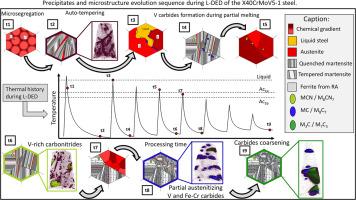Effect of intrinsic heat treatment on the precipitate formation of X40CrMoV5–1 tool steel during laser-directed energy deposition: A coupled study of atom probe tomography and in situ synchrotron X-ray diffraction
IF 8.3
1区 材料科学
Q1 MATERIALS SCIENCE, MULTIDISCIPLINARY
引用次数: 0
Abstract
Additively manufactured components are generally heat treated to remove the undesired microstructure formed during the repeated heating-cooling cycles inherent to the process, known as intrinsic heat treatment (IHT). Recently, the IHT has been explored as a driving force for precipitation hardening in steels which can potentially shorten the manufacturing chain of AM components. However, the mechanisms behind the formation of secondary phase precipitates during the complex thermal history remains unclear. In this work, a combination of in situ high energy X-ray diffraction, atom probe tomography, scanning and transmission electron microscopy were used to reveal the precipitation sequence in an X40CrMoV5–1 tool steel during laser-directed energy deposition (L-DED). V-rich MCN and V8CN7 carbonitrides, as well as, Fe-Cr-rich M3C and M7C3 carbides were formed at different stages of the L-DED. Their evolution and resulting chemical stoichiometry was correlated to the exact phase transformation occurring in the microstructure during the IHT over different regions along the built direction. Finally, the combined results from the in situ and ex situ experiments enabled us to retrace the history of the full microstructure during the L-DED process. The findings lead to the conclusion that secondary hardening effect in tool steel is, as expected, sensitive to the severity of the IHT, and if limited, can result in a tempered microstructure comparable to the ones conventionally obtained after tempering heat treatments.

激光定向能量沉积过程中内在热处理对 X40CrMoV5-1 工具钢沉淀形成的影响:原子探针断层扫描和原位同步辐射 X 射线衍射耦合研究
增材制造部件一般都要经过热处理,以去除在该工艺固有的反复加热-冷却循环过程中形成的不良微观结构,即所谓的固有热处理(IHT)。最近,本征热处理被认为是钢材沉淀硬化的一种驱动力,有可能缩短 AM 组件的制造链。然而,在复杂的热历史过程中形成次生相析出物的机制仍不清楚。在这项工作中,我们结合使用了原位高能 X 射线衍射、原子探针断层扫描、扫描和透射电子显微镜来揭示 X40CrMoV5-1 工具钢在激光能量沉积(L-DED)过程中的析出序列。在 L-DED 的不同阶段形成了富含 V 的 MCN 和 V8CN7 碳氮化物,以及富含 Fe-Cr 的 M3C 和 M7C3 碳化物。它们的演变和由此产生的化学计量学与沿建造方向不同区域的 IHT 期间微观结构中发生的确切相变相关联。最后,综合原位和非原位实验的结果,我们得以回溯 L-DED 过程中整个微观结构的历史。研究结果得出的结论是,工具钢中的二次硬化效应正如预期的那样,对 IHT 的严重程度非常敏感,如果受到限制,可以产生与传统回火热处理后获得的回火微观结构相当的微观结构。
本文章由计算机程序翻译,如有差异,请以英文原文为准。
求助全文
约1分钟内获得全文
求助全文
来源期刊

Acta Materialia
工程技术-材料科学:综合
CiteScore
16.10
自引率
8.50%
发文量
801
审稿时长
53 days
期刊介绍:
Acta Materialia serves as a platform for publishing full-length, original papers and commissioned overviews that contribute to a profound understanding of the correlation between the processing, structure, and properties of inorganic materials. The journal seeks papers with high impact potential or those that significantly propel the field forward. The scope includes the atomic and molecular arrangements, chemical and electronic structures, and microstructure of materials, focusing on their mechanical or functional behavior across all length scales, including nanostructures.
 求助内容:
求助内容: 应助结果提醒方式:
应助结果提醒方式:


